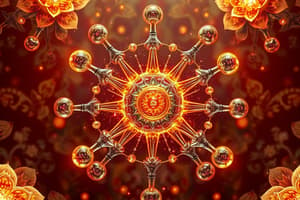Podcast
Questions and Answers
What is the main purpose of glycolysis?
What is the main purpose of glycolysis?
- To consume oxygen
- To generate a large amount of ATP
- To produce carbon dioxide
- To produce pyruvate from glucose (correct)
Where does the electron transport chain occur?
Where does the electron transport chain occur?
- On ribosomes
- In the mitochondria (correct)
- In the cytoplasm
- In the nucleus
Which of the following molecules is NOT directly involved in the citric acid cycle?
Which of the following molecules is NOT directly involved in the citric acid cycle?
- NADH
- ATP
- Acetyl-CoA
- Pyruvate (correct)
What is the purpose of meiosis?
What is the purpose of meiosis?
What is the role of electrons in cellular respiration?
What is the role of electrons in cellular respiration?
During translation, what molecule functions as a template for protein synthesis?
During translation, what molecule functions as a template for protein synthesis?
Which of the following statements about DNA is TRUE?
Which of the following statements about DNA is TRUE?
What is the function of ribosomes?
What is the function of ribosomes?
Which of the following statements accurately describes the base pairing rules in DNA?
Which of the following statements accurately describes the base pairing rules in DNA?
Which of the following BEST describes the role of valence electrons in chemical reactions?
Which of the following BEST describes the role of valence electrons in chemical reactions?
Flashcards
Parts of an Atom
Parts of an Atom
Atoms are made of protons, neutrons, and electrons; protons are positive, neutrons are neutral, and electrons are negative.
Function of Electrons
Function of Electrons
Electrons participate in chemical reactions by forming bonds between atoms.
Valence Electrons
Valence Electrons
Valence electrons are the outermost electrons responsible for chemical bonding and reactivity.
Polar Water
Polar Water
Signup and view all the flashcards
Functional Unit of Life
Functional Unit of Life
Signup and view all the flashcards
Glycolysis
Glycolysis
Signup and view all the flashcards
Citric Acid Cycle
Citric Acid Cycle
Signup and view all the flashcards
DNA Structure
DNA Structure
Signup and view all the flashcards
Mitosis Purpose
Mitosis Purpose
Signup and view all the flashcards
Translation
Translation
Signup and view all the flashcards
Study Notes
Atomic Structure and Subatomic Particles
- Atoms are composed of subatomic particles: protons, neutrons, and electrons
- Protons and neutrons are located in the nucleus
- Electrons orbit the nucleus
- Protons have a positive charge, electrons have a negative charge, and neutrons are neutral
- Electrons play a role in chemical reactions by transferring or sharing electrons
Valence Electrons
- Valence electrons are electrons in the outermost shell of an atom
- They are important as they determine the chemical properties of an atom, including how it will bond with other atoms
Water
- Water is a polar molecule due to the unequal sharing of electrons between oxygen and hydrogen atoms
Functional Unit of Life
- The functional unit of life is the cell
Cell Compartments
- Cells have compartments called organelles
- Major compartments in cells are the cytoplasm and nucleus (not mentioned, but inferred)
Cellular Organelles: Ribosomes, Golgi Apparatus, Mitochondria
- Ribosomes are responsible for protein synthesis
- Golgi apparatus modifies, sorts, and packages proteins
- Mitochondria are involved in cellular respiration and energy production
Cellular Respiration
- Cellular respiration is the process by which cells break down glucose to produce ATP (energy)
- The equation for cellular respiration is a key concept and should be understood: C6H12O6 + 6O2 → 6CO2 + 6H2O + ATP
Glycolysis
- Glycolysis is the first step in cellular respiration
- It takes place in the cytoplasm
- Glycolysis does not require oxygen
- Glucose is converted to a 3-carbon molecule (pyruvate)
Citric Acid Cycle
- The citric acid cycle occurs in the mitochondria
- Pyruvate is not fed directly into the citric acid cycle; it is first converted to AcetylCoA
Electron Transport Chain
- Electron transport chain is a series of proteins located in the mitochondria
- It is crucial for ATP production during cellular respiration
ATP Production
- Most ATP is produced in the mitochondria via cellular respiration.
DNA and Genes
- DNA is a double-stranded molecule
- The structure of DNA includes base pairing (adenine with thymine, guanine with cytosine)
- Genes are segments of DNA that contain the instructions for building proteins
- A chromosome is packaged DNA
DNA Replication, Transcription, Translation
- DNA replication creates a copy of a DNA molecule
- Transcription is the process where DNA is converted to RNA
- Translation is where RNA directs the synthesis of proteins.
- Protein synthesis takes place on the ribosomes.
Mitosis and Meiosis
- Mitosis is cell division for growth and repair, resulting in two identical cells
- Meiosis is cell division for sexual reproduction, resulting in four non-identical cells; each with half the number of chromosomes (haploid)
- Mitosis happens to body cells, and meiosis takes place in reproductive cells
- Cells are called diploid when they have a full set of chromosomes
- RNA is not found in the middle of the DNA double helix
Chromosomes
- DNA is wrapped around proteins called histones
Studying That Suits You
Use AI to generate personalized quizzes and flashcards to suit your learning preferences.




